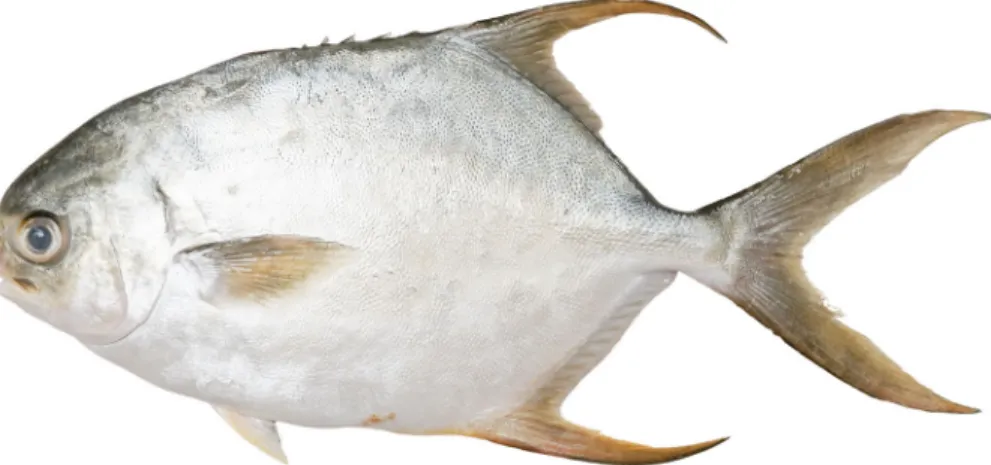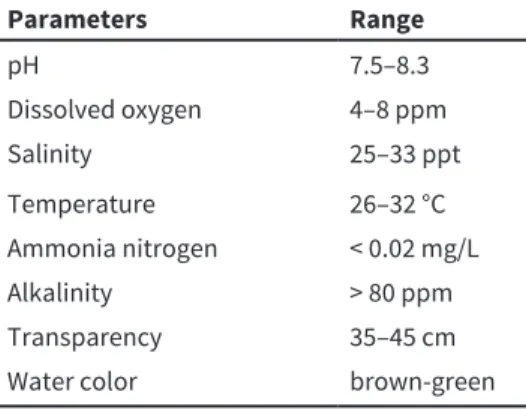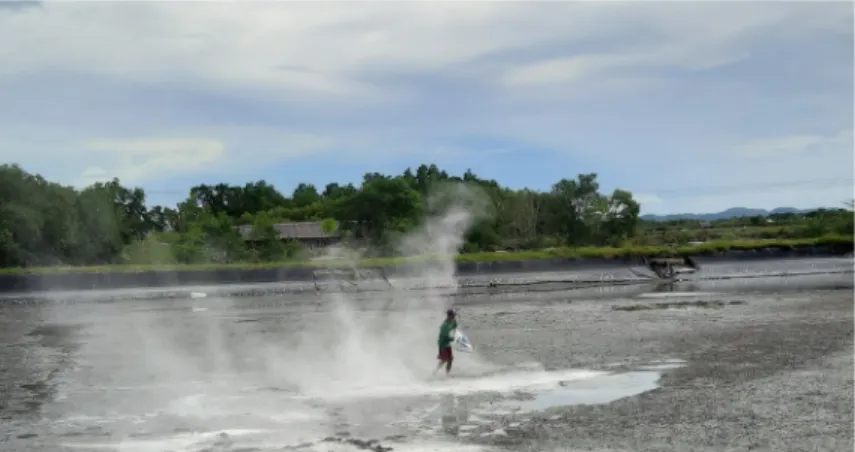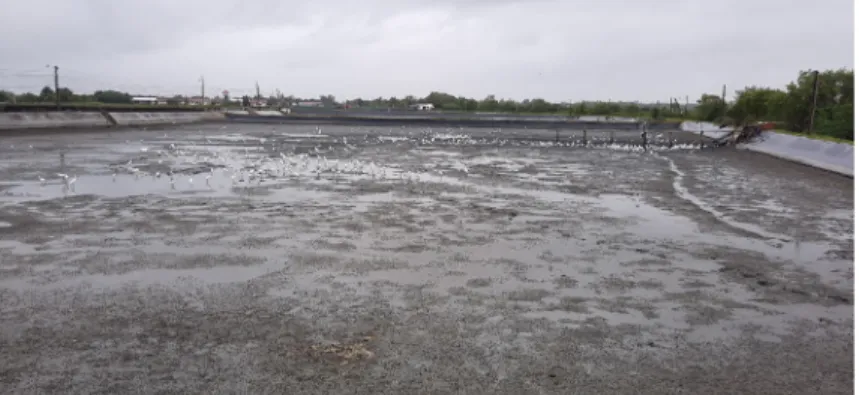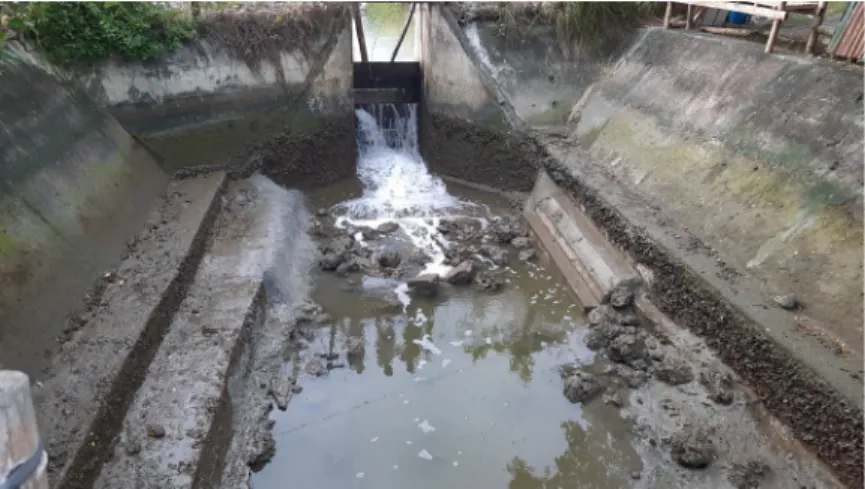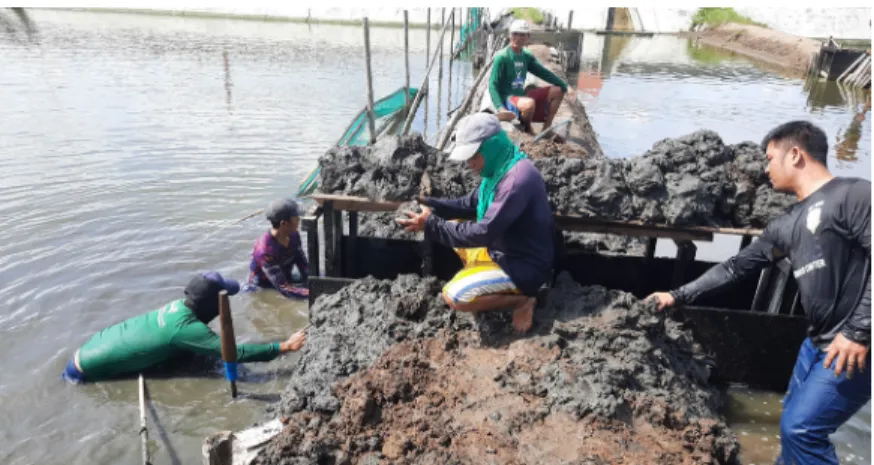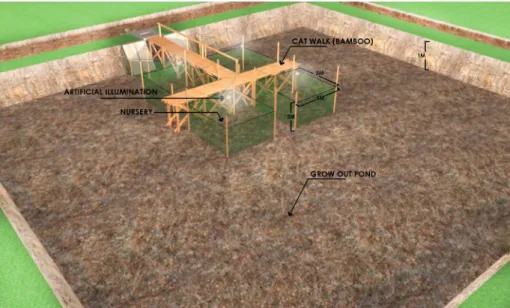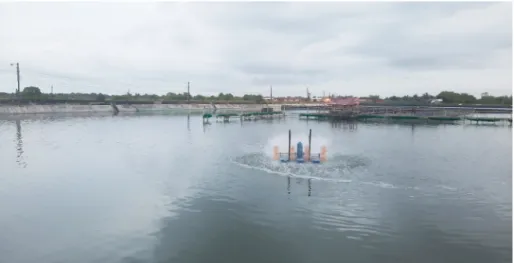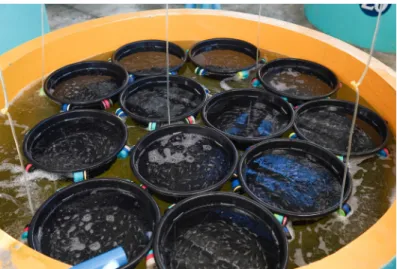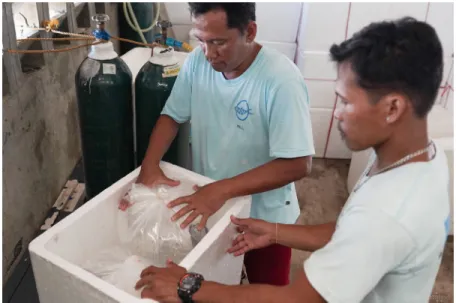Nursery and Grow-out Culture of Snubnose Pompano (Trachinotus blochii, Lacepede) in Brackishwater Ponds
Aquaculture Extension Manual No. 74 June 2023
Dan D. Baliao
Roger Edward P. Mamauag Leobert D. de la Peña
Edgar H. Somblingo Kyle Dymer L. Regatalio Rheniel Dayrit
Southeast Asian Fisheries Development Center AQUACULTURE DEPARTMENT
Tigbauan 5021, Iloilo, Philippines www.seafdec.org.ph
(Trachinotus blochii, Lacepede) in Brackishwater Ponds June 2023
ISSN 0115-5369
Published and printed by:
Southeast Asian Fisheries Development Center Aquaculture Department
Copyright © 2023
Southeast Asian Fisheries Development Center Aquaculture Department
Some rights reserved. This work is licensed under the Creative Commons Attribution-NonCommercial- ShareAlike 3.0 IGO License. To view a copy of this license, visit http://creativecommons.org/licenses/
by-nc-sa/3.0/igo/.
This license requires that reusers of the material give credit to the licensor, the Aquaculture Department of the Southeast Asian Fisheries Development Center. Reusers may distribute, remix, adapt, and build upon the material in any medium or format, for noncommercial purposes only and not in any way that suggests the licensor endorses the reuser. If others modify or adapt the material, they must license the modified material under identical terms.
For comments and inquiries:
Training and Information Division SEAFDEC Aquaculture Department Tigbauan 5021, Iloilo, Philippines (63-33) 330 7030
(63-33) 330 7031
devcom@seafdec.org.ph, aqdchief@seafdec.org.ph www.seafdec.org.ph
Baliao, Dan D.
Nursery and grow-out culture of snubnose pompano (Trachinotus blochii, Lacepede) in brackishwater ponds / Dan D. Baliao, Roger Edward P. Mamauag, Leobert D. de la Peña, Edgar H. Somblingo, Kyle Dymer L. Regatalio, Rheniel Dayrit. -- Tigbauan, Iloilo, Philippines : Aquaculture Dept., Southeast Asian Fisheries Development Center, 2023, ©2023.
25 pages : color illustrations. -- (Aquaculture extension manual, 0115-5369 ; no. 74).
Includes bibliographical references.
1. Trachinotus -- Cultures and culture media -- Handbooks, manuals, etc. 2. Brackish water aquaculture -- Handbooks, manuals, etc. 3. Pond culture -- Handbooks, manuals, etc. I. Mamauag, Roger Edward P. II. de la Peña, Leobert D. III. Somblingo, Edgar H. IV. Regatalio, Kyle Dymer L. V.
Dayrit, Rheniel. VI. SEAFDEC. Aquaculture Department. VII. Title.
SEAFDEC Aquaculture Department Library Cataloging-in-Publication Data Cover design by Joesyl Marie D. Aranas
Layout by Rossea H. Ledesma
Foreword
Pompano is an ideal fish for farming due to its exceptional taste, high market value, fast growth rates, adaptability to various aquaculture systems, relative disease resistance, and in view of the increasing demand for premium seafood.
Since 2007, the SEAFDEC/AQD has conducted extensive research on pompano farming, beginning with the development of breeding and seed production technologies. The research center has made significant progress in these areas and also in the nursery and grow-out phases.
Pompano health, nutrition, and feed development were also studied and articles have been published in reputable science journals. Furthermore, SEAFDEC/AQD has published laymanized manuals on pompano cage nursery culture in 2012 and hatchery seed production in 2014.
This latest aquaculture extension manual, "Nursery and Grow-out Culture of Snubnose Pompano (Trachinotus blochii, Lacepede) in Brackishwater Ponds," is another addition to the collection of farming technologies that are ripe for adoption by fish farmers. Valuable information on species biology, site selection, pond preparation, stocking, rearing techniques, and economics are included in this publication.
With its twin manual, "Nursery and Grow-out Culture of Snubnose Pompano (Trachinotus blochii, Lacepede) in Marine Cages," these publications are available to equip farmers with knowledge for cultivating snubnose pompano in both brackishwater ponds and marine cages. They are based on research and field trials, and aim to support fish farmers, industry stakeholders, and enthusiasts. It is my hope that all these further drive the growth and success of pompano aquaculture.
Dr. Sayaka Ito
Deputy Chief, SEAFDEC/AQD
About the Manual
This manual, titled “Nursery and Grow-out Culture of Snubnose Pompano (Trachinotus blochii, Lacepede) in Brackishwater Ponds,” includes culture techniques and good practices developed through extensive research done at the Aquaculture Department of the Southeast Asian Fisheries Development Center. The manual also tackles a viable technology that can guide fish farmers in raising pompano in brackishwater ponds.
Main sections included in this manual: 1. Biology, 2. Site Selection, 3. Pond Preparation, 4. Pond Maintenance, 5. Stocking of Fish, 6. Rearing (Nursery and Grow-out), and 7. Economics.
Contents
Foreword v About the Manual vi Introduction 1 Biology 1 Site Selection 3 Pond Preparation 4 Pond Maintenance 5 Stocking of Fish 8 Rearing (Nursery and Grow-out) 10 Economics 17 References 21 Acknowledgment 25 About the Authors 25
1 Introduction
The Aquaculture Department of the Southeast Asian Fisheries Development Center (SEAFDEC/AQD) has been at the forefront of developing aquaculture technologies for economically-important fish species in the Philippines.
Snubnose pompano (Trachinotus blochii Lacepede), locally known as
“pompano,” “damis lawin,” or “apahan” is a relatively new fish species for aquaculture in the country. Pompano can be reared in ponds and is a good substitute for grouper, snapper, and other high-value fish species. It is an attractive fish to grow in brackishwater ponds because it adapts well to the culture environment. It also readily accepts formulated diet and has good disease resistance. The meat characteristic of pompano is sought after by restaurants and consumers. However, the availability of this species in the market is still limited since its breeding and culture technology has not yet been widely disseminated in the country.
Over the years, SEAFDEC/AQD has developed the breeding, hatchery, and grow-out protocols of pompano through extensive research. These technologies enable and support the sustainable farming of pompano in the country. This manual presents a working technology that can guide fish farmers in growing pompano in brackishwater ponds.
2 Biology
General Features
• Body shape: The shape is commonly fusiform, displaying a typical oval shape, and elongated towards the posterior end.
• Color: Head and body are usually silver and dark blue gray at the top.
The snout and lower half of the body of adults is oftentimes golden orange. The fins are golden yellow with dusky tips while the pectoral
Figure 1. Snubnose pompano, Trachinotus blochii
Pompano belongs to the family Carangidae, which is considered a broad class of predatory pelagic fishes extensively scattered worldwide. The species of the genus Trachinotus are mostly considered excellent food fish and are listed in commercial fisheries indices. In their natural environment, pompanos feed on small shrimps, crabs, amphipods, and other benthic invertebrates. They require an energy-rich diet to support their high metabolic demand activity (i.e. continuous swimming in the wild and in captivity). They have a short digestive tract which translates into a short retention time, thus the ingredients used in the diet formulation should be highly digestible.
Pompanos are found in coastal (as an adult) and brackishwater (as larvae and juvenile) habitats. Due to their relatively efficient growth, superior meat quality, and capacity to easily adapt to formulated feeds, pompanos are considered a suitable species for commercial aquaculture.
fins are darker with fish greater than 75 cm. The second dorsal fin is dark and the fin lobe is dusky orange. The anal fin has a dusk orange hue.
• Other features: The snout is broadly rounded. Both jaws have bands of small villiform teeth.
3
SEAFDEC Aquaculture Department
3 Site Selection
The following factors should be carefully considered when selecting a location for pond aquaculture: abiotic factors (e.g. water supply, meteorological and hydrological conditions, and soil characteristics), pond inputs, and manner of operation.
1. Water
Water samples should be analyzed for their physico-chemical (i.e.
temperature, salinity, turbidity, suspended solids, pH, dissolved oxygen, and biological oxygen demand) and biological characteristics (i.e. microorganisms that are carriers of disease and abundance of plankton as primary productivity) (Table 1).
2. Weather
Data on precipitation, temperature, humidity, and monsoon patterns in the vicinity should be weighed.
3. Soil
Visual and chemical analysis (i.e. pH, phosphorus, calcium, magnesium, dissolved organic matter) of soil should be conducted.
The type of soil should be sandy clay to clay loam which is favorable for operation and to facilitate the growth of natural food in the pond bottom. Areas with a thick layer of organic soil should be avoided since it contributes to increased water seepage.
4. Inputs
Fry, feeds, fertilizers, and other farm implements should be available near the area of operation.
5. Operation
The land area will depend on the type of culture system (i.e. extensive or intensive) and production targets.
4 Pond Preparation
The pond soil should be dried thoroughly until the top soil has cracked, and then removed (Figure 2). This method will oxidize the organic matter and allow the growth of natural food. The process also eradicates unwanted species and microorganisms that are vectors of diseases.
In addition to sun drying, tea seed powder (15–20 mg per liter) can be applied or a combination of ammonium sulfate (21-0-0) and hydrated lime (Ca (OH)2) at a 5:1 ratio (Figure 3).
Tilling is done for soil nutrients to be made available in the production of primary food in the pond. The area is leveled and the pond bottom is constructed to slope towards the gate for easy draining during water management or harvest.
An inorganic fertilizer (46-0-0 or urea) is applied at a rate of 18–20 kg per hectare to enhance primary food productivity. Water is gradually admitted during high tide until the pond water level is at 80–100 cm.
Table 1. Optimum water parameters for pond culture of pompano
Parameters Range
pH 7.5–8.3
Dissolved oxygen 4–8 ppm
Salinity 25–33 ppt
Temperature 26–32 °C
Ammonia nitrogen < 0.02 mg/L
Alkalinity > 80 ppm
Transparency 35–45 cm
Water color brown-green
5
SEAFDEC Aquaculture Department
Pond Preparation
Figure 2. Draining of ponds in preparation for drying to oxidize organic matter and remove unwanted species
Figure 3. Application of hydrated lime to sterilize and increase nutrient availability in the ponds
5 Pond Maintenance
Dike
Leakages and the integrity of the structure should be thoroughly checked.
Canals should be clear of debris and dredged to an appropriate depth for an uninterrupted flow of water (Figure 4).
Figure 5. Repair of pond gates and dikes to prevent water seepage
Gates
To increase the efficiency of water exchange, biofoulers (e.g. oysters, barnacles, and algae) should be removed. Dilapidated gates and screens should be replaced to restrict the entry of unwanted species (Figure 5).
Figure 4. Clearing of debris in canals to provide efficient drainage system
Pond equipment
Life support systems such as water pumps and paddlewheels are on standby and will only be used during emergency conditions (i.e. low dissolved oxygen) (Figure 6).
7
SEAFDEC Aquaculture Department
Pond Maintenance
Figure 6. Provision of paddle wheel in the course of low dissolved oxygen in the pond
Figure 7. An illustration of a pompano pond integrated with a nursery and grow-out facility
The nursery facility is integrated into the pond grow-out system (Figure 7). Bamboo catwalks are installed for ease of movement during feeding and monitoring. A hut may also be constructed as a temporary shelter for personnel as well as interim storage for daily feed rations.
6 Stocking of Fish
Selection
Pompano fry should show no signs of physical deformities and disease symptoms (e.g. viral nervous necrosis and sea lice infection). Stocks should be homogenous in size (1-g body weight or 1.5-inch body length) to avoid cannibalism between fry as well as to ensure even sizes of fish during harvest. As much as possible, animals should be weaned to feed on formulated feeds prior to stocking in ponds.
Packing and transport
Animals should not be fed 24 hours prior to packing. From the hatchery tanks, fish are harvested, counted, and settled in aerated baskets overnight prior to packing and transport early the following morning (Figure 8).
Figure 8. Conditioning of pompano fry in aerated baskets prior to packing and transport to reduce stress
Double-layered 20 in x 30 in plastic bags are used to pack 150–200 pompano fry (0.5 g average body weight, 1-inch average body length). The bags should be filled with oxygen and seawater (7 L) at a volume ratio of
9
SEAFDEC Aquaculture Department
Stocking of Fish
Figure 9. Packing of pompano fry in oxygenated plastic bags
3:1. This packing density can sustain the fish for 8–12 hours of transport (Figure 9). Ice tubes (250 g) wrapped in paper are inserted between the outer and inner plastic bags to reduce water temperature. The plastic bags are then packed in styroboxes (Figure 10).
Figure 10. Plastic bags packed in styroboxes for an extended transport duration
Feeding is done four times a day (0800, 1200, 1400, and 1600) by following a suggested feeding rate (Table 2). Lighting fixtures can be installed in the pond to concentrate small aquatic animals such as crustaceans and rotifers (Figure 12). These zooplanktons will serve as a supplemental food to pompano fry. This method will reduce the cost of feeding formulated diets during the nursery phase.
Figure 11. Stocking of pompano fry gradually released in hapa nets. The fry will be reared for around 35 days
7 Rearing (Nursery and Grow-out)
Nursery
Hatchery-produced fry need to undergo a nursery phase where they will be reared to become fingerlings fit for grow-out. Pompano fry are stocked in hapa nets (B-net; 5 m x 5 m x 1.5 m) at a stocking density of 150 fish per cubic meter (Figure 11). Fish should be acclimated to pond conditions (i.e.
temperature and salinity) by gradually introducing pond water to opened container bags. The animals will be reared for 35 days or until they reach a body weight of 30 g.
11
SEAFDEC Aquaculture Department
Rearing (Nursery and Grow-out)
Figure 12. Artificial illumination in a nursery pond to attract natural food
Table 2. Adjusted feed rates for pompano based on the average body weight Fish weight (g) Feed rate
(% body weight) Size Phase
1-30 10–8 Mash/Crumble Nursery
31–60 7–6 Starter Grow-out
61–90 6–5 Starter/Grower Grow-out
91–120 6–5 Grower Grow-out
121–210 5–4 Grower Grow-out
211–290 4–3 Grower/Finisher Grow-out
291–360 3–2 Finisher Grow-out
Monitoring of stocks (i.e. feeding and swimming behavior) should be done frequently and thoroughly.
Grow-out
Pompano fingerlings with an average body weight of more than 30 g is transferred from the nursery hapa nets to grow-out ponds at a stocking density of two fish per square meter. To reduce stress, stocking should be performed early in the morning. It is suggested that undersized fish (less than 30 g) should not be included in the transfer. They can be returned to
Table 3. Nutrient and amino acid requirements of Trachinotus spp.
Nutrient Levels
Protein 39.5–42.7 % 1
Lipid 5.7 % 2
DP / DE3 23–25 mg/kJ 2
Amino acids
Methionine 1.19 % 1
Lysine 2.4–2.45 % 1
Taurine 1–1.5 % 1
Arginine 2.73–2.74 % 2
Leucine 2.9–3.2% 2
Isoleucine 4.0 % 2
Valine 1.9 % ²
Histidine 1.61 % 1
Phenylalanine 1.15 % ²
Threonine 1.39 % 2
Tryptophan 0.13 % 2
1Trachinotus blochii
2Trachinotus spp.
³Dietary protein to dietary energy ratio
the nursery nets for further rearing. The stocks are reared for about 175 days in the grow-out phase of an operation to attain a harvestable weight of ≈360 g.
Feeds and feeding management (Nursery and Grow-out)
The nutrient profile of feeds should meet the requirements of pompano (Table 3). Feed rations are divided into four parts during the nursery stage (0800, 1100, 1400, and 1700) and three parts (0800, 1100, 1400, and 1700) during the grow-out phase. Unlike other cultured fish, a pompano feeding regimen should not be “by satiation” as they tend not to cease ingesting even when full. Recording the daily feed consumption is vital as this information can provide accurate values when calculating performance parameters after harvest (Table 4).
13
SEAFDEC Aquaculture Department
Rearing (Nursery and Grow-out)
Table 4. Example of a daily feeding record to monitor feed consumption of fish Date Pond
No. Feed
ration Time Total Remarks
0800 1100 1400 1700 Nursery 0800 1200 1700 Grow-out
Sampling of stocks
A sample size of 5 % of the total stocks is weighed in bulk periodically (every 30 days) to monitor fish growth. Sampling data will then be analyzed for the prevailing average body weight of the fish. The average body weight is calculated using the equation below:
Average body weight (ABW) = total weight of fish sampled total number of fish sampled
To optimize feed efficiency, feeding ration is adjusted after stock sampling of the average body weight and survival (Figure 13). Feed rate recommendations serve as a guide to improve the nutrient efficiency of feeds and may be adjusted based on the prevailing condition of the fish and the environment. The feeding behavior of pompano is adversely affected during inclement weather conditions. The feed requirement is calculated using the equation below:
Feed requirement = (no. of stocks – mortality) × fish mean body weight × feeding rate 1,000
Feed stocks should be kept in a cool and dry storage facility to prevent spoilage and extend their shelf life. The nutrient availability and palatability of the diets are highly likely compromised with the growth of molds.
Figure 13. Periodic weight sampling of fish stocks
Monitoring
Water parameters such as dissolved oxygen, salinity, pH, temperature, and turbidity should be closely monitored. When parameters are below optimum, water change should be conducted via tidal cycles or pumping during emergency cases.
Fish vitality should be checked, this is observed in the swimming and feeding behavior, physical abnormalities, and symptoms of diseases.
During a suspected disease outbreak, live or fresh fish samples should be subjected to microbiological analysis. This is to ascertain the causative agent and the specific control measures to be applied.
Harvest
Fish stocks can be harvested when they attain a marketable size of 350 g. A seine net is used to aggregate fish adjacent to the dike for easy collection (Figure 14). To maintain optimum fish quality, pre-chilled seawater is used to immediately reduce fish flesh temperature (Figure 15). Prepared in a chilling tank, the recommended ice-to-fish ratio is 1:1 (by weight). The chilled fish are packed in Styrofoam boxes with sufficient ice (i.e. 1:1 ratio).
An arrangement of a layer of crushed ice at the bottom of the container and in between rows of fish should be followed.
15
SEAFDEC Aquaculture Department
Rearing (Nursery and Grow-out)
The computation of the fish performance parameters after every harvest is critical in every pond aquaculture production. These data will allow farm operators to re-evaluate their general operating protocol, especially feed management. The performance parameters data should be recorded thereafter (Table 5). The following fish performance parameters are computed using the equations below:
Figure 14. Seining of pompano during harvest
Figure 15. Harvested pompano placed on chilled ice to maintain optimum fish quality
Weight gain (%) = final weight - initial weight initial weight x 100
Specific growth rate = ln (final weight) - ln (initial weight)
no. of days x 100
Feed conversion ratio = total feed intake final biomass - initial biomass
Survival (%) = no. of stocks final
no. of stocks initial x 100
Growth rate of pompano reared in brackishwater ponds weighed every 30 days is presented in Figure 16.
Table 5. Example of a sampling record for performance parameters Sampling
period Pond No. Days of Culture ABW
(g) Mortality Total feed
intake FCR SGR
Figure 16. Growth of pompano from nursery to grow-out in brackishwater pond for 210 days
17
SEAFDEC Aquaculture Department
8 Economics
Table 6 defines the technical information of a five-year farm investment plan for pompano pond operations. The associated investment items, costs, depreciation, and the required re-investments are presented in Table 7. As indicated, the more liquid capital assets of the farm are expected to be used until the farm ceases to operate after five years.
From the given assumptions in Table 6, a cost and return analysis is provided in Table 8 to estimate the net return of pompano grow-out operation in the pond. Also, the economic efficiency indicators are generated showing the high profitability of the single-run grow-out operation. The existing farm operation is expected to recover its initial investment cost after a single run and the estimated free cash flow could even be possibly used for another run. The break-even analysis proves that the operation could absorb changes of at most 40 % in the foregoing assumptions and remain profitable.
Table 9 provides the financial investment analysis and estimates the net income, net present value, internal rate of return, and discounted benefit- cost ratio for a 5-year operation after a 2 % annual increase in sales and a 1
% annual increase in cost are assumed. The following discounted financial indicators highlight the viability of the pompano grow-out operation in the pond.
Validated by the aforementioned information, the grow-out culture of pompano in the pond is a profitable and viable undertaking.
Table 6. Technical information in pompano pond operations
Project duration (year) 5
Culture period (days, nursery to grow-out) 210
Total pond area for stocking (m²) 10,000
Stocking density (pcs/m²) 2
Number of fingerlings stock per crop (pcs) 20,000 Number of pompano at harvest per crop (pcs) 17,800
Survival rate 89 %
Average body weight, final (g) 360
Average body weight, initial (g) 1
Total weight gain (kg) 6,390
Total feed consumed (kg) 12,432
Feed conversion ratio 1.94
Volume of harvest per crop 6,408
Number of crops/year 1
Volume of harvest per year 6,408
Farm-gate price per kg body weight (PHP) 350
Table 7. Investment items, costs, depreciation, and re-investments Investment Items Cost
(PHP) Economic Life (Year)
Depreciation
(PHP) Reinvestment in Year 3 (PHP)
Field hut 30,000 2.5 12,000 30,000
Bamboo poles for foot
walk 10,000 2.5 4,000 10,000
Seine net 5,000 2.5 2,000 5,000
Water pump, 1 hp 27,000 5 5,400
Paddle wheel, 2 hp 5
units 175,000 5 35,000
Miscellaneous items 24,700 5 4,940
Total (PHP) 271,700 63,340 45,000
19
SEAFDEC Aquaculture Department
Economics
Table 8. Cost and return analysis
Gross revenue per year (PHP) (PHP 350/kg, 6,480 kg) 2,242,800
Gross revenue per crop (PHP) 2,242,800
Cost
A. Variable Cost
Fingerlings (PHP 10.00/pc) 200,000
Feeds (PHP 80/kg, 12,432 kg feed consumed) 994,522
Fuel 10,000
Pond preparation (PHP 20,000/ha) 20,000
Maintenance and repairs, 5 % of investment costs 13,585
Transportation/Electricity cost 20,000
Hired labor/harvester (PHP 400/day) 4,000
Total variable cost per crop 1,262,107
Total variable cost per year 1,262,107
B. Fixed Cost
Rent of pond (PHP 20,000/ha) 20,000
Permits and licenses (PHP 5,000/yr) 5,000
Depreciation cost 63,340
Pond aide salary (PHP 10,000/month) 70,000
Opportunity cost of own capital (2.5 %/annum) 6,793
Total fixed cost per crop 165,133
Total fixed cost per year 165,133
Total production cost per crop (PHP) 1,427,239
Total production cost per year (PHP) 1,427,239
Economic efficiency indicators Net income per year (PHP)
(gross revenue – total cost) 815,561
Return on investment (ROI, %)
(net income/investment cost) x 100 300.17 %
Return on feed cost (%)
(net income/feed cost) x 100 82.01 %
Payback period, years
[investment cost/(annual net income+annual depreciation)] 0.31 Break-even price (PHP/kg)
(total cost/total production) 222.73
Break-even volume of production (kg/crop)
(total cost/selling price) 4,078
Table 9. Financial Investment Analysis Year 0Year 1Year 2Year 3Year 4Year 5Total Gross Income (PHP)*-2,242,8002,287,6562,333,4092,380,0772,427,67911,671,621 Investment Cost (PHP)271,700--45,000--316,700 Variable and fixed cost, less depreciation (PHP)-1,363,899 1,377,538 1,391,313 1,405,227 1,419,279 6,957,256 Total cost investment and operating costs (PHP)**271,7001,363,899 1,377,538 1,436,313 1,405,227 1,419,279 7,273,956 Net income including earnings from depreciation (PHP)
(271,700)878,901 910,118 897,096 974,851 1,008,400 4,397,665 Net Present Value (NPV, PHP)2,950,399 Internal Rate of Return (IRR, %)326.06 % Discounted Benefit-Cost Ratio (DBCR) (NPV of gross incomes/NPV of costs)1.58
*2 % annual increase in sales value due to several factors such as improved operations and skills, higher survival rate, and probable price increase **1 % annual increase in cost due to probable increase in prices of materials and labor
21
SEAFDEC Aquaculture Department
9 References
Berry, F. and E.S. Iverson. 1967. Pompano: Biology, Fisheries and Farming Potential. Proceedings of the Gulf and Caribbean Fisheries Institute 19:
116-128.
Cruz-Lacierda, E.R., Pagador, G.E., Yamamoto, A. and Nagasawa, K., 2011.
Parasitic caligid copepods of farmed marine fishes in the Philippines.
Diseases in Asian Aquaculture VII. Selangor, Malaysia: Fish Health Section, Asian Fisheries Society, 385.
Ebeneezar, S., Vijayagopal, P., Srivastava, P.P., Gupta, S., Varghese, T., Prabu, D.L., Chandrasekar, S., Varghese, E., Sayooj, P., Tejpal, C.S. and Wilson, L., 2019. Dietary lysine requirement of juvenile Silver pompano, Trachinotus blochii (Lacepede, 1801). Aquaculture, 511, p.734234.
Ebeneezar, S., Vijayagopal, P., Srivastava, P.P., Gupta, S., Varghese, T., Prabu, D.L., Chandrasekar, S., Varghese, E., Tejpal, C.S., Anikuttan, K.K. and Sayooj, P., 2020. Optimum dietary methionine requirement of juvenile silver pompano, Trachinotus blochii (Lacepede, 1801). Animal Feed Science and Technology, 268, p.114592.
FAO 2023. Cultured Aquatic Species Information Programme (CASIP).
Fisheries and Aquaculture Division [online]. Rome.
Fermin, A.C. and Seronay, G.A., 1997. Effects of different illumination levels on zooplankton abundance, feeding periodicity, growth and survival of the Asian sea bass, Lates calcarifer (Bloch), fry in illuminated floating nursery cages. Aquaculture, 157(3-4), pp.227-237.
Gaitan, A. G., Toledo, J. D., Arnaiz, M. T., Ayson, E. V. D. J., Altamirano, J.
P., Agbayani, R. F., Salayo, N. D., & Marte, C. L. 2014. Milkfish Chanos chanos cage culture operations. Tigbauan, Iloilo, Philippines:
Aquaculture Department, Southeast Asian Fisheries Development Center.
Garcia, L.M.B., Hilomen-Garcia, G.V., Celino, F.T., Gonzales, T.T. and Maliao, R.J., 2012. Diet composition and feeding periodicity of the seahorse Hippocampus barbouri reared in illuminated sea cages. Aquaculture, 358, pp.1-5.
Hardy, R.W. and Kaushik, S.J. eds., 2021. Fish nutrition. Academic press.
Hauville, M.R., Zambonino-Infante, J.L., Bell, G., Migaud, H. and Main, K.L., 2014. Impacts of three different microdiets on Florida Pompano, Trachinotus carolinus, weaning success, growth, fatty acid incorporation and enzyme activity. Aquaculture, 422, pp.268-276.
Huang, Z., Lin, H.Z., Peng, J.S., Tan, X.H., Zhou, W.C., Zhou, C.P. and Lei, M.H., 2015. Effects of dietary isoleucine levels on the growth performance, feed utilization, and serum biochemical indices of juvenile golden pompano, Trachinotus ovatus. Israeli Journal of Aquaculture-Bamidgeh, 67, pp.1-9.
Huang, Z., Tan, X.H., Zhou, C.P., Yang, Y.K., Qi, C.L., Zhao, S.Y. and Lin, H.Z., 2018. Effect of dietary valine levels on the growth performance, feed utilization and immune function of juvenile golden pompano, Trachinotus ovatus. Aquaculture Nutrition, 24(1), pp.74-82.
Jayakumar, R., Nazar, A. K. A., Tamilmani, G., Sakthivel, M., & Gopakumar G., 2014. Farming of silver pompano Trachinotus blochii in coastal aquaculture ponds [Brochure]. Kochi, India: Central Marine Fisheries Research Institute.
Jobling, M., 2016. Fish nutrition research: past, present and future.
Aquaculture international, 24(3), pp.767-786.
Ladja, J. M., Opiña, N., Catacutan, M., Vallejo, E., & Cercado, V., 2012.
Cage nursery of high-value fishes in brackishwater ponds: seabass, grouper, snapper, pompano. Tigbauan, Iloilo, Philippines: Aquaculture Department, Southeast Asian Fisheries Development Center.
Lazo, J.P., Davis, D.A. and Arnold, C.R., 1998. The effects of dietary protein level on growth, feed efficiency and survival of juvenile Florida pompano (Trachinotus carolinus). Aquaculture, 169(3-4), pp.225-232.
Lin, H., Tan, X., Zhou, C., Niu, J., Xia, D., Huang, Z., Wang, J. and Wang, Y., 2015. Effect of dietary arginine levels on the growth performance, feed utilization, non-specific immune response and disease resistance of juvenile golden pompano Trachinotus ovatus. Aquaculture, 437, pp.382-389.
Mamauag, R.E.P. and Ragaza, J.A. 2023. Histidine requirement of snubnose silver pompano, Trachinotus blochii. Animal Feed Science and Technoloogy:115690.
23
SEAFDEC Aquaculture Department
References
Mamauag, R.E.P., Catacutan, M.R., Coloso, R.M., Erazo-Pagador, G., Mallare, M. and Ragaza, J.A., 2021. Dietary taurine in practical diet for two sizes of snubnose silver pompano, Trachinotus blochii. Aquaculture Nutrition, 27(6), pp.2231-2239.
Mamauag, R.E.P., Ragaza, J.A. and Nacionales, T.J., 2021. Performance, digestibility efficiencies, gut and liver morphologies of snub nose pompano Trachinotus blochii fed spray-dried haemoglobin meal as protein substitute for fishmeal. Aquaculture Research, 52(11), pp.5849- 5856.
Palma, P.A., Beluso, L.A.A., de Jesus-Ayson, E.G.T. and Cruz-Lacierda, E.R., 2022. Seasonal population dynamics of Lepeophtheirus spinifer and Neobenedenia sp. coinfecting snubnose pompano (Trachinotus blochii) breeders in marine cages in the Philippines. Veterinary Parasitology, 302, p.109656.
Prabu, D.L., Ebeneezar, S., Chandrasekar, S., Kalidas, C., Kavitha, M., Vijayagopal, P., Anikuttan, K.K. and Jayakumar, R., 2022. Evaluation of a modified feeding strategy on the growth, metabolism and feeding economics of Snubnose Pompano Trachinotus blochii (Lacepede, 1801) in a recirculatory system. Animal Feed Science and Technology, 290, p.115348.
Reyes, O. S., de Jesus-Ayson, E. G. T., Pedroso, F. L., & Cabanilla, M. I. C., 2014. Hatchery production of snubnose pompano Trachinotus blochii Lacepede. Tigbauan, Iloilo, Philippines: Aquaculture Department, Southeast Asian Fisheries Development Center.
Sun, J.L., Liu, Y.F., Jiang, T., Li, Y.Q., Song, F.B., Wen, X. and Luo, J., 2021.
Golden pompano (Trachinotus blochii) adapts to acute hypoxic stress by altering the preferred mode of energy metabolism. Aquaculture, 542, p.736842.
Surtida, M. B., 2000. The pompano. SEAFDEC Asian Aquaculture, 22(3), 27.
Tan, X., Lin, H., Huang, Z., Zhou, C., Wang, A., Qi, C. and Zhao, S., 2016.
Effects of dietary leucine on growth performance, feed utilization, non- specific immune responses and gut morphology of juvenile golden pompano Trachinotus ovatus. Aquaculture, 465, pp.100-107.
Tutman, P., Glavić, N., Kožul, V., Skaramuca, B. and Glamuzina, B., 2004. Preliminary information on feeding and growth of pompano, Trachinotus ovatus (Linnaeus, 1758)(Pisces; Carangidae) in captivity.
Aquaculture International, 12(4-5), pp.387-393.
Weirich, C.R., Riley, K.L., Riche, M., Main, K.L., Wills, P.S., Illán, G., Cerino, D.S. and Pfeiffer, T.J., 2021. The status of Florida pompano, Trachinotus carolinus, as a commercially ready species for US marine aquaculture.
Journal of the World Aquaculture Society, 52(3), pp.731-763.
Wu, Y., Han, H., Qin, J. and Wang, Y., 2015. Effect of feeding frequency on growth, feed utilization, body composition and waste output of juvenile golden pompano (Trachinotus ovatus) reared in net pens.
Aquaculture Research, 46(6), pp.1436-1443.
25
SEAFDEC Aquaculture Department
Acknowledgment
The authors would like to thank Mr. Clark Macalde who made the pond illustration; Ms. Pedrita Caballero for the photo of illuminated nursery ponds of pompano; and the Dumangas Brackishwater Station technical staff Mr. Jesus Apelacio, Ms. May Vincent Arellano, and Ms. Julie Biogos.
The authors are grateful to the Publications Review Committee for their invaluable reviews and comments.
This research is funded by SEAFDEC/AQD under the study code TV-05- F2021D.
About the Authors
Dr. Roger Edward P. Mamauag started his career with SEAFDEC/AQD in 1997. He is currently a scientist and the head of the Technology Verification and Extension Division. He earned his Ph.D. in Fisheries Science from Kagoshima University.
Mr. Dan D. Baliao is the current chief of SEAFDEC/AQD, a position he has held since 2017. He has previously held various research and administrative positions at SEAFDEC/AQD in 1979–1986 and 1996–2013. He earned his Master of Science in Fisheries (major in Aquaculture) degree from the University of the Philippines in 1978.
Dr. Leobert D. de la Peña has been with SEAFDEC/AQD from 1987. He is currently a scientist and the head of the Research Division. He earned his Ph.D. (Fish Pathology) degree from the Hiroshima University Graduate School of Biosphere Sciences.
Mr. Edgar H. Somblingo entered SEAFDEC/AQD in 2004. He is presently assigned at the Dumangas Brackishwater Station as a technical assistant of the Technology Verification and Extension Division. He earned his Bachelor of Science in Fisheries degree from the Iloilo State College of Fisheries.
Mr. Kyle Dymer L. Regatalio is a senior technical assistant at the Dumangas Brackishwater Station. He earned his Bachelor of Science in Chemistry degree from the University of the Philippines Visayas. He joined SEAFDEC/AQD in 2019.
Mr. Rheniel Dayrit has been with SEAFDEC/AQD since 2016 and is currently a technical assistant at the Technology Verification and Extension Division. He earned his Bachelor of Science in Economics degree from the University of the Philippines Visayas in 2016.
The Southeast Asian Fisheries Development Center (SEAFDEC) is a regional treaty organization established in December 1967 to promote fisheries development in the region. The member countries are Brunei Darussalam, Cambodia, Indonesia, Japan, Lao PDR, Malaysia, Myanmar, Philippines, Singapore, Thailand, and Viet Nam.
The policy-making body of SEAFDEC is the Council of Directors, made up of representatives of the member countries.
ABOUT SEAFDEC
SEAFDEC has five departments that focus on different aspects of fisheries development:
• The Training Department (TD) in Samut Prakan, Thailand (1967) for training in marine capture fisheries
• The Marine Fisheries Research Department (MFRD) in Singapore (1967) for post-harvest technologies
• The Aquaculture Department (AQD) in Tigbauan, Iloilo, Philippines (1973) for aquaculture research and development
• The Marine Fishery Resources Development and Management Department (MFRDMD) in Kuala Terengganu, Malaysia (1992) for the development and management of fishery resources in the exclusive economic zones of SEAFDEC member countries, and
• Inland Fishery Resources Development and Management Department (IFRDMD) in Palembang, Indonesia (2014) for sustainable development and management of inland capture fisheries in the Southeast Asian region.
AQD is mandated to:
• Conduct scientific research to generate aquaculture technologies appropriate for Southeast Asia
• Develop managerial, technical and skilled manpower for the aquaculture sector
• Produce, disseminate and exchange aquaculture information
AQD maintains four stations: the Tigbauan Main Station and Dumangas Brackishwater Station in Iloilo province; the Igang Marine Station in Guimaras province; and the Binangonan Freshwater Station in Rizal province. AQD also has an office in Quezon City.
